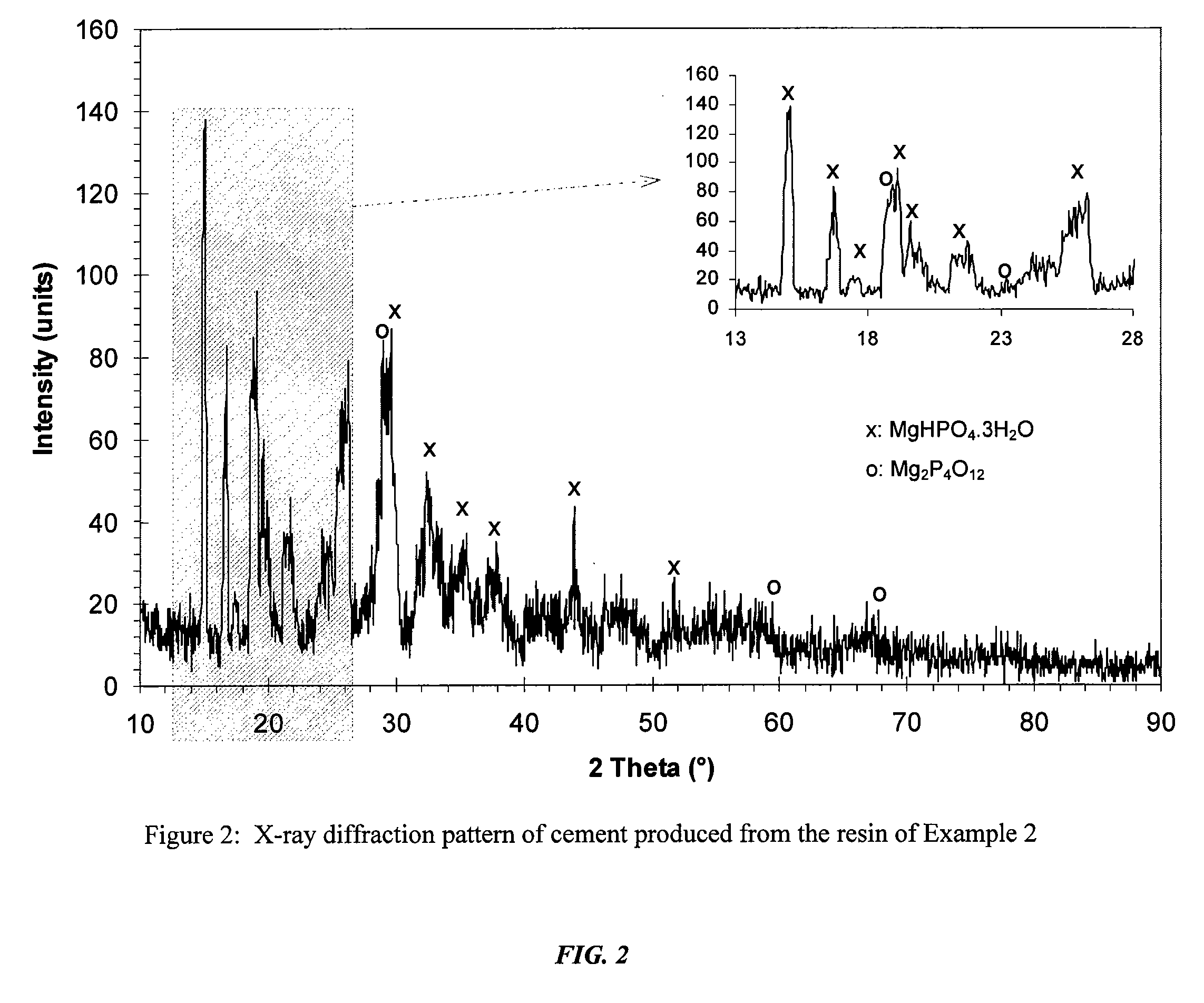Inorganic Phosphate Resins and Method for Their Manufacture
a technology of phosphate resin and resin, which is applied in the direction of phosphorus oxide, solid waste management, sustainable waste treatment, etc., can solve the problems of high intensity, relatively high cost of resin, and health hazards for users, so as to reduce the cost of final product, the effect of less time for mixing, pumping and application of cement paste, and safer transportation of resin
- Summary
- Abstract
- Description
- Claims
- Application Information
AI Technical Summary
Benefits of technology
Problems solved by technology
Method used
Image
Examples
example 1
[0048]Production of storable resin. In this test, 260 grams of 75% concentrated H3PO4 were added to 180 ml of water, and the acid was added to the water in a Hobart table top mixer very slowly, i.e., for at least 30 minutes and as long as one hour, to ensure that the mixture did not overheat. To this mixture were added 40 grams of magnesium oxide that was calcined at 2,400° F. Addition of the oxide was also carried out very slowly, i.e., for at least 30 minutes and as long as one hour, to ensure that the acid-base reaction did not generate an excessive amount of heat. When all oxide was added, the pH of the paste was 2.65. The paste was then allowed to mix for several hours until it formed a very thick paste and further mixing became difficult. The container was left open to allow further drying. The paste settled into solid chunks, which were stored in closed plastic containers. The results of the analysis of the solid chunks using X-ray diffraction instrumentation are shown in FIG...
example 2
[0049]Production of acid-base cement from resin pulp. This test demonstrates the ability of using a resin made by the methods described herein, and dissolving it in water in order to produce an acid-base cement. The process involves adding a small amount of MgO (or any other sparsely soluble oxide) as an activator to the resin. The resulting paste sets slowly into hardened cement (MgHPO4.3H2O). The stoichiometry that governs the setting reaction is given by:
MgO+Mg(H2PO4)2.4H2O+H2O=2MgHPO4.3H2O (5)
[0050]The technique of using the resin instead of powder of Mg(H2PO4)2.2H2O provides much more work time. In this test, 50 grams of resin were diluted in 16 ml of water to make a solution. To this solution were added 6 grams of MgO very slowly, i.e., for at least 30 minutes, so that the MgO powder was thoroughly mixed and no excessive amount of heat was generated. Mixing continued for an additional 15 minutes, and the paste was then allowed to cure. The paste heated in 5 minutes and set. F...
example 3
[0051]Production of resin partially activated with MgO. The test in Example 2 shows that set cement is formed when the stoichiometric amount of MgO is added. The test in Example 3 demonstrates the ability to produce a partially activated storable resin which, when heat-treated, results in solid cement. The test began with a solution of magnesium dihydrogen phosphate resin. While mixing continuously, MgO was added slowly, i.e., for at least 30 minutes, so that all of it became wet and reacted. Only 20% of the MgO was held back, and it was found that the paste was still thin. The paste was then dried and could be stored. However, instead of storing it, the paste was further dried at 50° C. and then continued to be heated. The result was set cement. This means that it is possible to produce cement with sub-stoichiometric amount of MgO and with some heat treatment. FIG. 3 shows that the only significant phases found in set cement are newberyite and excess MgO. Interestingly, significant...
PUM
| Property | Measurement | Unit |
|---|---|---|
| Temperature | aaaaa | aaaaa |
| Temperature | aaaaa | aaaaa |
| Temperature | aaaaa | aaaaa |
Abstract
Description
Claims
Application Information
 Login to View More
Login to View More - R&D
- Intellectual Property
- Life Sciences
- Materials
- Tech Scout
- Unparalleled Data Quality
- Higher Quality Content
- 60% Fewer Hallucinations
Browse by: Latest US Patents, China's latest patents, Technical Efficacy Thesaurus, Application Domain, Technology Topic, Popular Technical Reports.
© 2025 PatSnap. All rights reserved.Legal|Privacy policy|Modern Slavery Act Transparency Statement|Sitemap|About US| Contact US: help@patsnap.com



